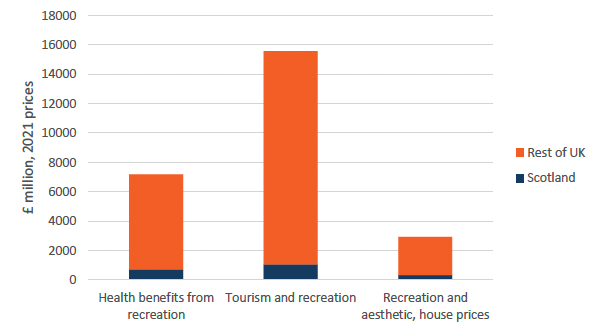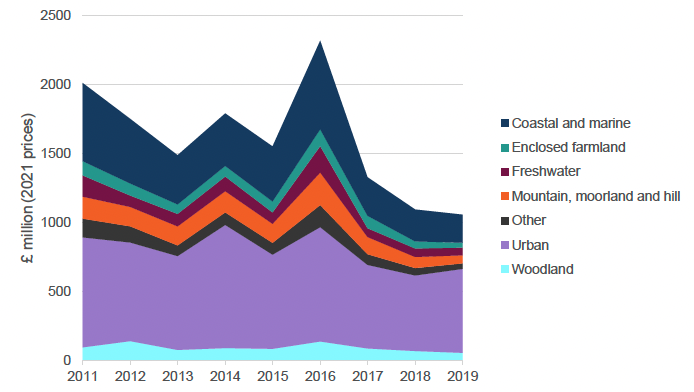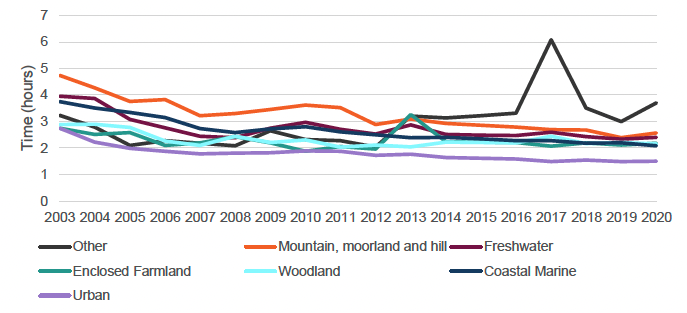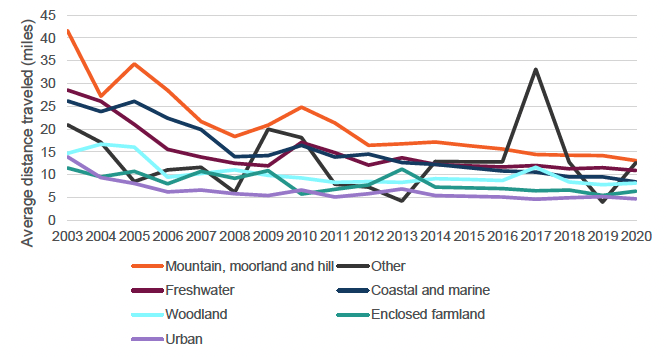Scottish Natural Capital Accounts: 2023
This report estimates quantity and value of services supplied by Scotland's natural capital.
7. Cultural services
Cultural services are the non-material benefits we obtain from ecosystems through recreation, tourism and the associated health benefits. Within the Scotland accounts there are three distinct forms of cultural services:
- house prices (recreation and aesthetic) - recreation house prices include the additional value on houses that are near to green (land) and blue (water) spaces, enabling people to make "free trips" to the natural environment, while aesthetic house prices include how much value is added to a house that has a view of a green and/or blue space
- tourism and recreation - spending on travel to the natural environment and some aspects of expenditure incurred during visits (parking fees, transport costs, vehicle running costs and admissions)
- health benefits from recreation - the value associated with improved health and well-being resulting from regular visits to nature
In 2019, the annual value of cultural services in Scotland was £2 billion, making up 8% of the total value of UK cultural services. This is in line with Scotland accounting for 8% of the UK population. Scotland accounted for 7% of the UK's annual value from nature for tourism and recreation, 10% of health benefits from recreation, and 11% of recreation and house prices.
For these cultural services, we are able to quantify both welfare benefits, explored further by the Outdoor Recreation Valuation model, and the more direct and transactional aspects such as recreation and people's engagement with the outdoors. The natural environment provides a space for recreational activities, which in turn, creates additional satisfaction, pleasure and enjoyment while reducing levels of stress and anxiety.
The recreation estimates were produced using the Scottish Recreation Survey (ScRS) and the Scotland's People and Nature Survey (SPANS). These surveys gather evidence and trend data relating to people's enjoyment, access, understanding of and attitudes to the natural environment, and contributions to well-being.

Annual value of cultural services in Scotland and the rest of the UK, £ million, 2019
Source: UK natural capital accounts from the Office for National Statistics
House prices (recreation and aesthetic)
Recreation house prices include the additional expenditure on houses that are near to green (land) and blue (water) spaces, enabling people to make "free trips" to the natural environment, while aesthetic house prices estimate the value added to a property by a view of a green or blue space.
We are currently updating this methodology, so have not included detailed figures in this bulletin. However, the annual value from house prices that can be attributed to living near to nature was £313 million in 2019. This measures the value of the "free trips" to these spaces within 500 metres of the house.
Tourism and recreation
The value of tourism and recreation includes spending on travel to the natural environment and some aspects of expenditure incurred during visits, including parking fees, transport costs, vehicle running costs and admissions. The annual value of tourism and recreation in Scotland was £1 billion in 2019.
The surveys used to calculate the figures for tourism and recreation focus on both short recreational day trips from home, trips equal to or shorter than three hours, and all spending on outdoor activity. We also include visits and expenditure from international travellers through data from the International Passenger Survey (IPS).
Despite several country specific surveys being used to calculate estimates, results are comparable across the four nations because of the application of the same methodology. This is further explored in our Scotland natural capital accounts methodology: 2023.

Recreation, total visits (million), Scotland, 2003 to 2020
Sources: Natures Scot, The Scottish Recreation Survey (ScRS) and the Scotland's People and Nature Survey (SPANS)
Tourism and recreation trips have increased from 366 million in 2011 to 569 million in 2020. Visits to natural spaces in urban areas made up most of these visits, averaging 48% of total visits across the period. Destinations have changed during this period, with urban, freshwater and woodland habitat types exhibiting the largest rates of increase.
The reduction in total visits to nature in 2020 is likely to be partly because of coronavirus (COVID-19) pandemic-related travel restrictions.

Total expenditure on tourism and recreation, Scotland, £ million (2021 prices), 2011 to 2019
Source: NatureScot and The Scottish Recreation Survey (ScRS)
Between 2011 and 2019 there was a decline in total expenditure across all habitats of 4% a year on average, from £2 billion to £1 billion. Coastal marine and urban destinations accounted for 77% of expenditure in 2019.
An increasing number of people are choosing to walk or cycle to natural spaces instead of using cars. This change in transport method has led to a 42% decline in travel costs between 2011 and 2019. See further information in Scotland's People and Nature Survey 2019/20 – outdoor recreation, health, and environmental attitudes modules.
Typically, longer trips are associated with higher travel costs and declines in average length of trip (Figure 20) have driven the reduction in annual expenditure.

Time (hours) spent per recreational visit, Scotland, 2003 to 2020
Source: NatureScot and Scotland's People and Nature Survey
Between 2011 and 2020, total time on day trips to nature increased by 38% to 1 billion hours, while total visits increased by 58% to 612 million over the same period. This resulted in a decline in the duration of each visit of 13%.

Average distance travelled (miles) per recreational visit, Scotland, 2003 to 2020
Source: NatureScot, The Scottish Recreation Survey (ScRS) and the Scotland's People and Nature Survey (SPANS)
Mountain, moorland and hill habitats had the greatest distance travelled per visit at 13 miles in 2020, a decline of 69% from 2003. All habitats witnessed a decline in the average travel distance ranging from a 44% to 69% decrease since 2003. Urban natural spaces as destinations for tourism had the shortest average distance travelled at 5 miles, because of the proximity of urban housing to urban natural spaces.
Health benefits from recreation
The annual value of health benefits is estimated at £717 million in 2020, up 32% from £544 million in 2011.
Research has shown that there are clear health benefits from spending time in nature. For example, according to the paper Spending at least 120 minutes a week in nature is associated with good health and wellbeing by White and others (2019), spending at least 120 minutes a week in nature gives statistically significant health advantages. Our modelling uses this as a minimum threshold, with only those meeting this considered to have experienced benefits. See further information in our Health benefits from recreation, natural capital, UK: 2022 bulletin.

Total number of people, million, who gained health benefits from outdoor recreation, Scotland, 2009 to 2020
Sources: Nature Scot, The Scottish Recreation Survey (ScRS) and the Scotland's People and Nature Survey (SPANS)
The number of people who gained health benefits within Scotland from time spent in nature reached 2 million in 2019, increasing an average of 3% a year between 2009 and 2020.
The fall of 25,000 people benefitting from nature between 2019 and 2020 was driven by a decline in the average length of trips taken. The average duration of a trip was 133 minutes in 2011, which fell to 116 minutes in 2020. As a result, people are less likely to meet the 120-minute threshold.
Although urban areas consistently featured as the most popular habitat for deriving health benefits from nature, freshwater habitat visits increased the most relatively, doubling between 2009 and 2020. Mountains, moorland, and hill areas saw a 5% decline in visits over the same period.

Percentage of the population of the four UK nations that gained health benefits from exposure to nature, 2009 to 2020
Sources: UK natural capital accounts from the Office for National Statistics, Monitor of Engagement with the Natural Environment for England, Scotland's People and Nature Survey, National Survey for Wales, and People and Nature Survey
The proportion of the population that gained health benefits from time spent in nature has seen a long-term upward trend from 2009 to 2020, for all four UK nations (Figure 23). Scotland typically has the highest proportion of people benefitting from nature, reaching 48% in 2020.
Contact
There is a problem
Thanks for your feedback